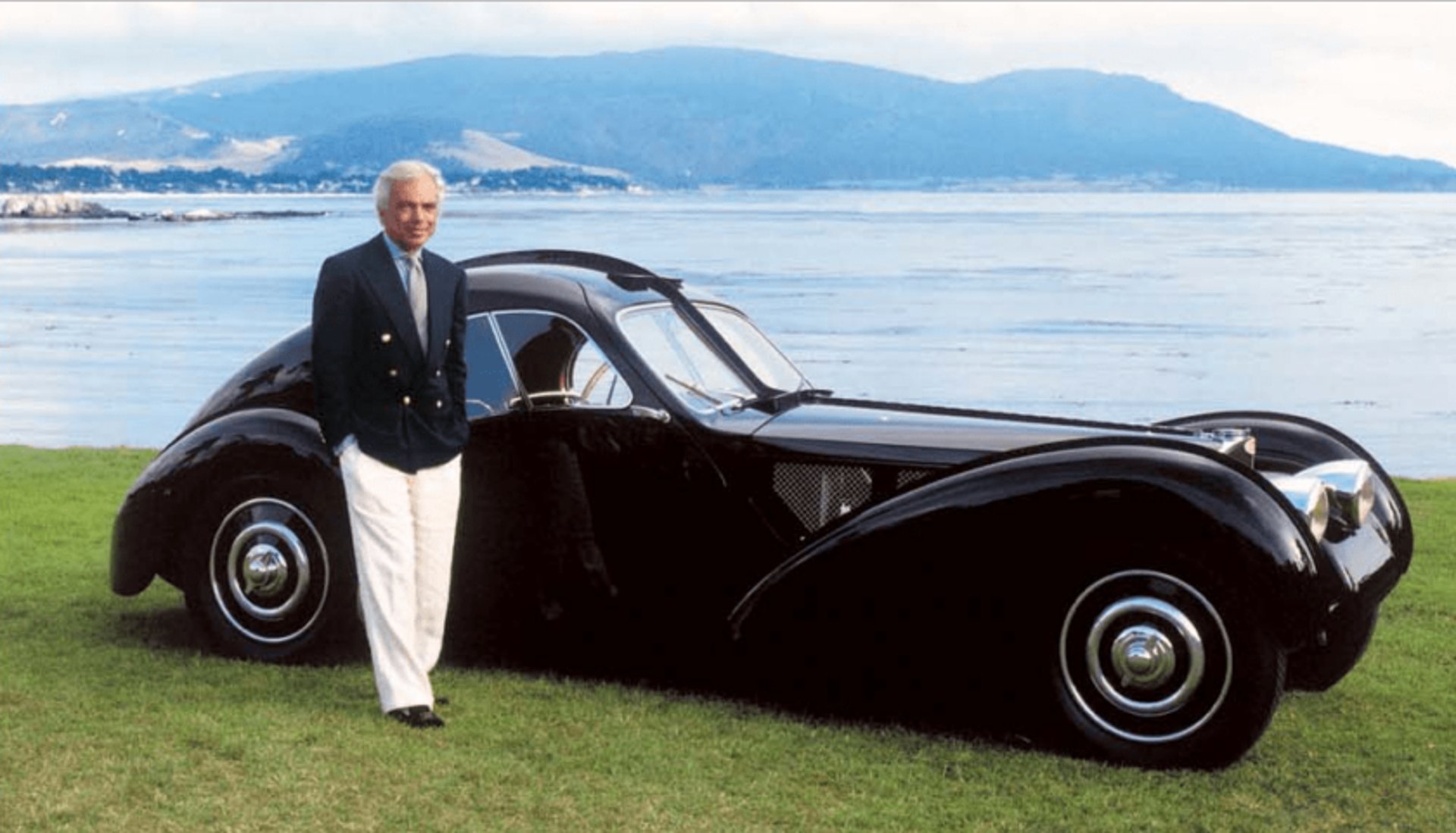
THE BLAZER GUIDE
Discovering The Debonair, Article 2
Raymond K. Ndokwo
9 min read


THE BLAZER GUIDE
Ralph Lauren in a Navy Double Breasted Blazer and White Trousers
he blazer stands as a seminal element in classic menswear and remains an indispensable item in a gentleman’s wardrobe. Yet, over the years, the term “blazer” has become increasingly ambiguous. To ensure you make the most of its extraordinary adaptability, this guide will clearly define what a blazer is, examine its origins, explore modern renditions, and offer insights on how to wear it with distinction.
T
What Exactly Is a Blazer?
Eight Defining Traits of a Blazer
Given how vague and incomplete these dictionary entries are, we must turn to menswear literature and practical consensus to discern the defining features of a blazer. In many regions, “blazer” is a catch-all term for any type of jacket, particularly in women’s fashion. However, for our purposes, we’ll stick to the technical menswear definition:
A blazer is a standalone jacket worn with trousers of a different color, pattern, or fabric.
It may be solid in color or feature bold, vibrant stripes.
Solid tones are predominantly navy blue, although shades such as red, bottle green, and white are also classic.
It may include decorative piping, braiding, or contrast trim.
Configurations range from double-breasted (6×2, 6×3, 8×3) to single-breasted with one to three buttons.
Buttons—one of the blazer’s hallmark features—are typically contrasting and made from mother-of-pearl, silver, pewter, brass, or gilt. These may bear anchors and scrolls (often called “Nelson buttons”) or the insignia of schools, clubs, or associations.
A second defining feature, in some cases, is a crest or emblem on the breast pocket, signifying affiliation and often the individual’s rank within the organization.
Blazers are typically crafted from navy serge. Alternatives include hopsack, worsted wool, and flannel, while fresco and linen are suited for warm weather. Striped versions often come in wool flannel or cotton.
As its popularity expanded, the blazer became part of the dress code for schools and universities across the British Empire. Typically adorned with a badge and sometimes piping, school blazers denote various accomplishments—special colors or badges are awarded for specific achievements. Sports and gentlemen’s clubs adopted a similar system, giving rise to what we now call Club Blazers. Regimental Associations in the British and Commonwealth armies also developed their own versions—Regimental Blazers. These feature distinct badges and buttons, and the detailing varies by association. A unique feature within the British Guards regiments, for example, is the number of cuff buttons: one for Grenadier Guards, two for Coldstream, three for Scots, four for Irish, and five for Welsh Guards.
Initially associated with elite groups and institutions, blazers were once seen as exclusive garments. However, that perception faded as their popularity grew. By the early 20th century, striped blazers were a staple among dandies in the U.S., especially through retailers like Brooks Brothers. British Mods revived the look in the 1960s, giving it renewed fashion relevance. Blazers also held deep associations with traditional gentlemanly sports, enhancing their upper-class image. Today, such associations mostly linger in cricket, where captains often don blazers bearing their team’s insignia during ceremonial moments like the coin toss.
When the colder months arrive, a proper wool flannel blazer is a wonderful choice—provided it won’t be part of your daily uniform. For heavier use, opt for a worsted flannel variant, which offers greater resilience over time. Both styles provide added warmth, and the slightly fuzzy surface of flannel makes it especially suitable for layering during fall and winter.
For those seeking a more indulgent winter option, cashmere or vicuña delivers unmatched softness and elegance. These noble fibres feel exquisite and lend the blazer a luxurious character, though they come at a significantly higher price. That said, it’s often wise to invest in versatile wardrobe staples, and a blazer made of cashmere or vicuña certainly qualifies as such.
Blazer Details
As we’ve noted earlier, there’s a wide range of options when it comes to blazer buttons. While gold remains the most traditional—and silver a close second—don’t overlook alternatives like mother of pearl in white or grey, which can be just as eye-catching. Light-toned horn buttons also make for an elegant touch. Ultimately, your button choice should reflect your personal taste, so take your time and select what best suits your style.
Double-breasted blazers typically feature peaked lapels and either a 6×2, 6×3, or 8×3 configuration. Historically, these jackets were unvented, but side vents are now more common. Center vents are less appropriate due to their equestrian origins. Patch pockets are increasingly fashionable, though flap pockets remain standard.
Single-breasted styles generally feature notched lapels and two or three buttons. Whether you prefer patch or flapped pockets is a matter of taste. Vents at the sides are preferable to a single vent.
When having a blazer made to measure, many opt for a bold red lining, though green or yellow can be equally striking. A solid navy lining remains a timeless choice. While badges and crests are best reserved for appropriate occasions, decorative buttons are always a refined touch.
Fit and Silhouette
A blazer should fit similarly to a suit jacket, though some prefer a slightly looser, longer cut akin to a sport coat. Canvas structure and shoulder padding vary—traditional double-breasted styles are more structured, whereas Neapolitan tailoring favors soft shoulders and minimal lining.
The supposed national styles—American, English, and Italian—offer general references:
American: Soft shoulders, two-button front, notch lapels, single vent, often with patch pockets.
English: More structured, single- or double-breasted, notched or peaked lapels, and double vents.
Italian: Lightweight, less structured fabrics, often more relaxed in fit.
In truth, these classifications are outdated. A skilled tailor anywhere in the world can produce garments in any of these styles to your preference.
How to Wear a Blazer
A blazer, like a waistcoat, is incredibly versatile and can be worn with a variety of trousers and shirt combinations.
White Flannel Trousers
A classic pairing from the 1930s. Add a pale blue shirt, green tie or ascot, and a boutonniere for a refined finish. Oxblood or white shoes complete the look.
Grey or Camel Flannel
Another elegant option. Pair with a white or pale-colored shirt and a silk tie—grenadine, knit, or challis. Black shoes for grey trousers; brown or oxblood for camel hues.
Chinos
Khaki chinos are a traditional partner to the navy blazer, with roots in military dress. Don’t shy away from colors like olive, yellow, or Nantucket red for a preppy flourish.
Corduroy or Cavalry Twill
These are excellent fall options in rich tones like burgundy or rust.
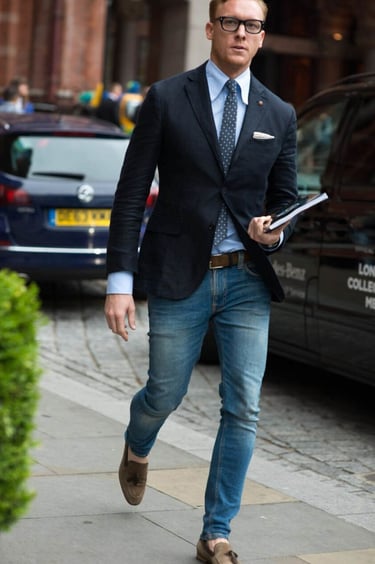

Jeans should be avoided unless approved by management
Jeans
While purists may object, a blazer with jeans can work for relaxed settings. Combine with loafers and an open-collar shirt.
Today, the blazer is one of the most flexible garments in menswear, suitable for everything from casual to semi-formal environments. It complements a wide array of garments and lends polish to nearly any outfit. For anyone building a timeless wardrobe, the blazer is undoubtedly the most valuable and adaptable item you can own.
Striped blazer in blue, orange, and burgundy with 2 cuff buttons, patch pockets worn with bow tie & boater hat & modern striped blazers
The History of the Blazer
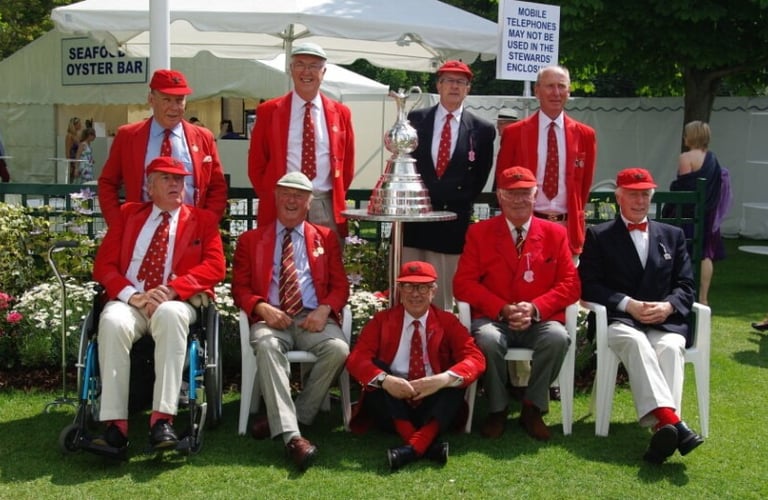

Scarlet red blazers of members of the Lady Margaret Boat Club
Origin 1 – The Lady Margaret Boat Club
The Lady Margaret Boat Club, formed in 1825 by a group from St. John’s College, Cambridge, dressed in eye-catching scarlet flannel jackets. Because these garments “blazed,” the name “blazer” was coined. The club still adheres to this tradition. Interestingly, only certain members are permitted to wear gold piping and buttons—those with First May Colours. Members with First Lent or Second May Colours are allowed silver buttons only.
Origin 2 – The H.M.S. Blazer
British Naval uniforms in the mid 1800s
The second, more widely accepted, theory dates to 1837, when Queen Victoria planned an inspection of the H.M.S. Blazer. Its commander, dissatisfied with the existing uniforms, outfitted his men in smart double-breasted jackets with brass Royal Navy buttons to make a better impression. At the time, Royal Navy uniforms were not standardized, so this bespoke outfit made a significant impression. While the sailors continued to wear blue and white striped jackets until at least 1845, the term “blazer” gained traction and eventually became mainstream by 1889.
A reader of the London Daily News voiced his indignation that the word had been diluted:
“A blazer is the red flannel boating jacket worn by the Lady Margaret, St. John’s College, Cambridge, Boat Club… It seems from your article that a blazer now means a colored flannel jacket, whether for cricket, tennis, boating or seaside wear.”
In retrospect, he clearly lost that semantic battle.
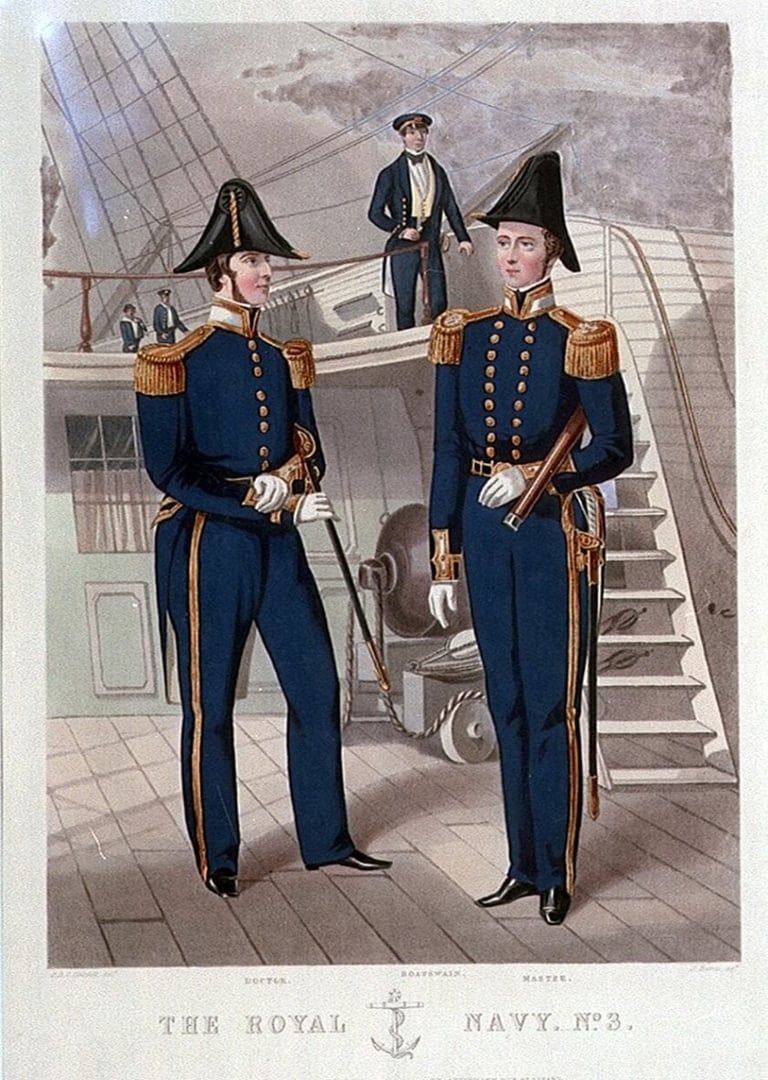

The Blazer and Institutions
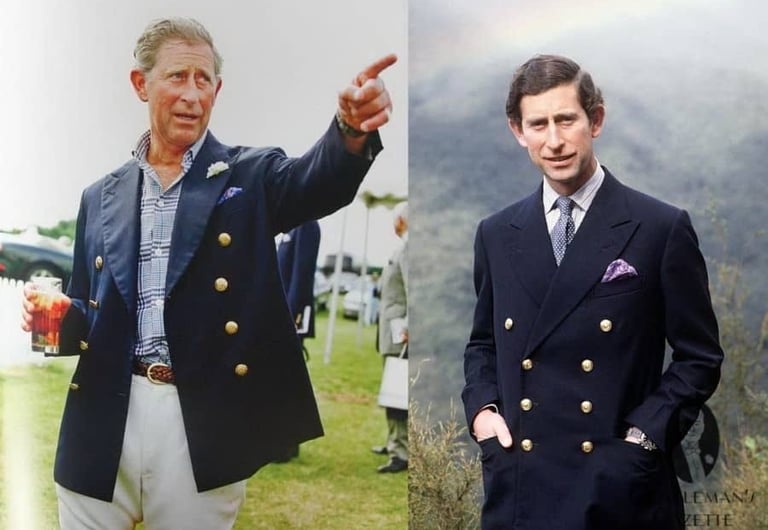

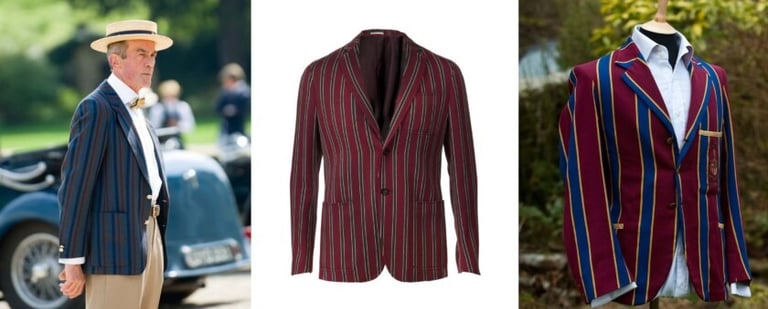

Prince Charles in the same navy 8×3 double-breasted blazer, years apart
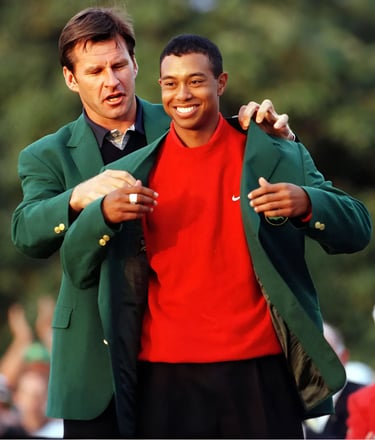

Tiger Woods' 1997 Augusta Masters win
Two major sporting events still award blazers as trophies: the Masters Golf Tournament in Augusta (green blazer) and the Congressional Cup Regatta (crimson blazer) in Long Beach, California.
At present, the Henley Royal Regatta is perhaps the foremost showcase for bold, colorful, or striped boating blazers. For a deep dive into this tradition, the book Rowing Blazers by Jack Carlson with photography by F.E. Castleberry is a delightful and well-researched reference.
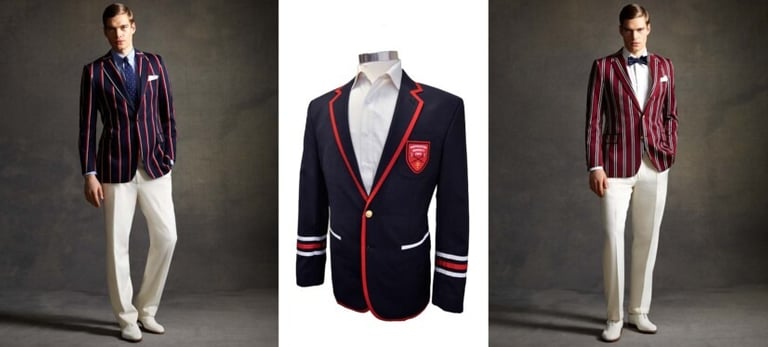

Modern College & Boating blazers in navy, red, white and green with piping and optional crest
Rowing or Regatta Blazers
The Henley Royal Regatta in 1893 marks a significant point in the history of rowing blazers, and today it stands as arguably the foremost event for blazer enthusiasts around the world. For those who are unable to attend the event in person, there is still a way to immerse oneself in the rich culture and visual splendour of these boldly striped or intricately braided garments—through the coffee table book Rowing Blazers by Jack Carlson, with photography by F.E. Castleberry. This volume is a treasure trove of information and imagery that captures the spirit of regatta style and the heritage of these eye-catching blazers. A selection of various boating blazer styles is presented below, offering a glimpse into the diversity and character of this sartorial tradition.
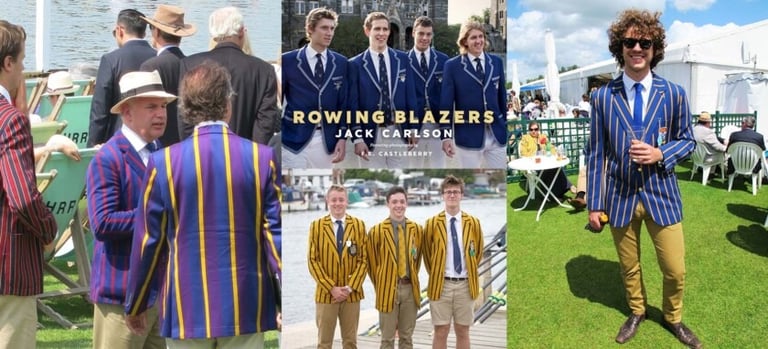

Rowing Blazers at Henley Royal Regatta
Blazer Fabrics
Navy Serge
Navy serge, a worsted wool fabric, remains the quintessential material for a classic blazer. Most often woven from merino wool, it features a distinctive twill weave. From my experience, it tends to develop a sheen in areas that experience regular friction. For that reason, take extra care when pressing or dry cleaning it—excessive heat or direct contact with an iron can leave an unflattering glossy finish. If your preference leans toward a shinier appearance, consider a wool and mohair blend instead; it will provide a more refined sheen than a worn-out serge ever could.
Hopsack
Hopsack is recognized by its loose, basket-like weave, which adds immediate texture and dimension to any outfit. However, this openness in the weave also makes it more susceptible to snagging. If you spend a lot of time around children, pets, or environments where the fabric could easily catch, then hopsack might not be the most practical fabric for your blazer.
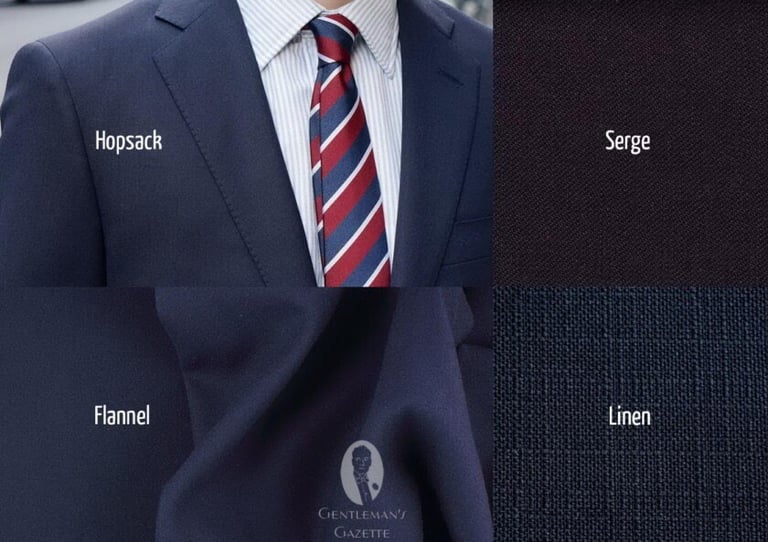

Blazer fabrics – Serge, hopsack, wool flannel, linen, worsteds…
Fresco or Linen
If you’re based in a region where the climate leans consistently warm, you’ll want to consider blazers made of fresco or linen. Some gentlemen shy away from linen due to its tendency to wrinkle easily, while others embrace that quality as part of its charm. If you fall into the former group, then fresco—crisp, breathable, and wrinkle-resistant—comes highly recommended.
Flannel
Cashmere or Vicuña
To begin, we must confront the most perplexing question: what, in precise terms, constitutes a blazer? Many assume it to be any jacket worn independently of matching trousers. The Oxford American Dictionary labels it as “a sports jacket not worn with matching trousers.” The Oxford English Dictionary, in contrast, defines it as “a coloured jacket worn by schoolchildren or sports players as part of a uniform,” or “a plain jacket not forming part of a suit but considered appropriate for formal wear.” The Free Dictionary characterizes it as “a lightweight, often striped or brightly coloured sports jacket with pockets and notched lapels.” Merriam-Webster calls it “a jacket worn over a shirt, resembling a suit jacket but not part of a suit.” Not terribly illuminating, is it?
If identifying what makes a blazer distinct is challenging, tracing its historical roots is just as complex. Multiple theories exist concerning the origin of the term “blazer”—one account claims there are as many as ten! But the two main origin stories stand out.
Ray Boule
CELEBRATING THE ESSENCE OF THE DEBONAIR
© 2025. All rights reserved.
By signing up to our newsletter you agree to our Terms and Conditions
